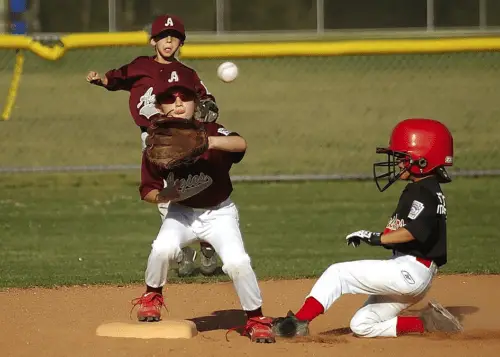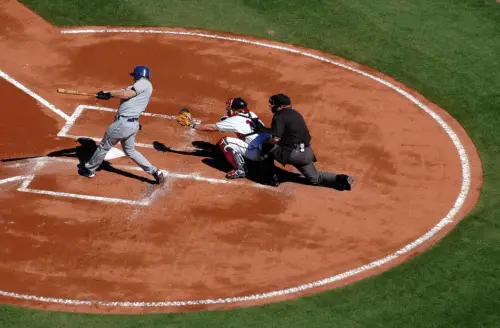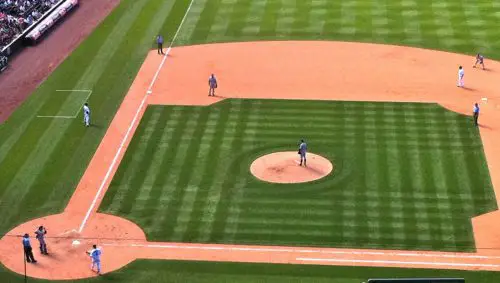Baseball Rules, Strageties, Equipment and more!
RULES:
Baseball rules can be a bit confusing, but we’ll try to keep it simple. It really boils down to two teams with nine players on each side trying to score more runs than the other over the course of nine innings. In each inning, teams are allowed three outs during their turn to hit. Once the third out is called, the defense switches with the offense and tries to score. An “out” is basically a charge against the team at bat, and a player at bat (or a base runner) can be called out in many ways which will be summarized in this article.
The ball is put into play by a pitcher who throws the ball over a plate that a batter stands beside. An umpire calls balls and strikes that determine how the at-bat is completed. Strikes are called by the umpire when a batter swings and misses or when the baseball crosses the plate in the area of the batter from their knees to the letters on their jerseys. Pitches outside this strike zone are called balls. A hitter is allowed to go to first base after four pitched balls in an at-bat.
Pitches that are hit but land in foul territory are considered strikes unless the batter already has two strikes. At this point, there is no limit on the number of foul balls a hitter can deliver without being called out. The exception to this rule is if a player tries to bunt with two strikes and hits the pitch into foul territory then the batter is out.
A batter is also out when they either collect a combination of three called or swinging strikes in an at-bat, hit a ball on the ground in fair territory and are thrown out at first base before they can reach safely or a hit a ball that is caught in the air by a defensive position player.

A batter is scored with a hit when they put the ball in play without the ball being caught in the air, or being tagged out by a defender with the baseball, and if they reach first base before the ball is thrown to the first baseman and they touch first base with their foot.
SCORING:
Runs are scored when a baserunner touches home plate safely. The most popular way to score runs is via the home run where a batter hits the ball over the fence in fair territory.
Other exciting ways a baserunner can score is by hitting an inside-the-park home run where the batter circles the bases before the defense can tag the runner out.
One of the more embarrassing ways a pitcher can allow a run is by walking in a runner. This happens when the bases are loaded, this term means baserunners occupy each base, and a pitcher walks in a run by throwing four balls to the batter during an at-bat.
With a runner on third, a hitter can be credited with a sacrifice fly by hitting a fly ball deep into the outfield that allows the runner to score once the ball is caught. If the caught fly ball is not the third out, the runners can tag the base they are on and advance to the next base beginning with the moment the ball is caught by the position player. It can be a risky move because the fielder is allowed to throw the ball to a fellow defender in an attempt to place a tag on the runner. If tagged before the baserunner safely reaches any base, including home plate, then the runner is out.
Typically, baserunners score when the batter hits either a single, double or triple that moves the runners ahead on the base paths allowing them to score safely.
EQUIPMENT:
Commonly used equipment for the baseball player consists of three items. First, there is a baseball that is used for all actions in a game. The next essential item is a glove that all nine position players wear during their time playing defense on the field. And finally, there is a bat that is used to hit the pitches thrown by the pitcher.
Baseballs are made with leather, yarn, and a cork center. The ball is assembled by first wrapping the cork in yarn and then covering the wound ball with two pieces of leather that are stitched together to create seams. Pitchers use these seams for better grip and to throw pitches with a break.
Gloves are made with pre-cut sections of leather that are stitched and laced together with padding included inside the glove to lessen the brunt of hard-hit line drives and quick throws. Catchers and the first baseman have different gloves that help them dig and secure throws. Infielders tend to have shorter gloves that aid in collecting grounders while outfielders use longer gloves for securing fly balls.
Bats are typically made from wood and aluminum. In the professional baseball leagues such as MLB, aluminum bats have been banned, and hitters can only use wooden bats that meet specifications. The three types of wood used for bats include Maple, Ash, and Birch.
In college and lower levels, aluminum bats are used for their durability. These metal bats are lighter in weight and can generate quicker bat speeds for increased exit velocity. Baseball associations regulate baseball rules fairly strictly, and aluminum bats are regulated so that the ball flies off at acceptable speeds to reduce possible injury to the pitcher and infielders.
PLAYER POSITIONS:
On defense, the play begins when the pitcher throws a pitch towards the batter who is standing next to home plate. This pitch is caught by the catcher who sits behind the plate to receive pitches and then covers (any gameplay action at) the plate, if necessary when a batted ball is put into play. Around the infield, there is a baseman for each base. The first, second, and the third baseman patrol the area around the corresponding base. Between the second base and third base, a shortstop covers the gap on the left side of the infield.

In the outfield, there are three outfielders each named by the location they cover defensively. In right field, a right fielder handles all batted balls sent their way. Right fielders typically have strong throwing arms so that they can make the throw from right field to third base. In center field, a center fielder handles the most significant area as they must cover the distance between the right-field gap to the left field gap. Center fielders usually have terrific sprinting speed to cover this broad section of the field. Finally, in left field, the left fielder is responsible for fly balls and grounders that get through the left side of the infield.
FIELD LAYOUT:
The field is laid out like a diamond with four bases that outline a path that baserunners use to score runs. First base is down the right-field foul line, 90 feet from home plate. Second base is set directly in the center of the field behind the pitcher’s mound. Third base is housed on the left field foul line, and home plate is placed 60 feet and 6 inches from the pitching plate, also directly in the center of the field. The distance between the bases in all levels of advanced play is set 90 feet from the prior base.
A wall of varying heights lines the entire playing surface of the baseball field. The outfield wall that spans in fair territory from the left field foul pole to the right field foul pole is the barrier that determines home runs (if the ball is hit over the fence in that area) or the area of fair play if the ball is hit between the foul poles but not over the fence. Any baseball that leaves the hitter’s bat without touching the ground and clears the top of this outfield fence is a home run. Also, any batted ball that strikes a foul pole above the top of the fence is considered a home run.
Balls that go into foul territory during an at-bat are considered out of play when they exit the field over the walls. Spectators are not allowed to reach over the fence and into the area of the playing field. If a spectator leans over the wall and interferes with a fielders’ ability to catch a live fly ball, then the umpire has the discretion to call the batter out if they feel the position player would have made the catch.
STRATEGIES:
The advanced strategies that baseball teams use to win games have evolved considerably over the years. Tactics that have lasted throughout baseball’s rich history are the intentional walk, the sacrifice bunt and its exciting brother, the suicide bunt.
The history of the intentional walk traces back to the dead ball era circa 1900. The intentional walk is when the pitcher throws four straight balls on purpose to put the batter on first base. There are several strategic reasons to use the intentional walk. One of the most popular is to avoid the opposing team’s best hitter or to set up the double play by placing the runner on first.

The sacrifice bunt has been used throughout the years by managers to move a runner over into a more promising scoring position. In Major League Baseball, the National League still has the pitchers take their turn at-bat as opposed to the American League where they utilize a Designated Hitter for the pitcher’s spot in the lineup. Pitchers in the National League often use the sacrifice bunt to move baserunners over so that the better hitters in the lineup have the opportunity to hit them in for a run.
One of baseball’s most exciting plays is the suicide bunt. This play can only happen when there is a runner on 3rd base. The manager will signal for two actions to occur simultaneously. The first is for the hitter to bunt and the second is for the baserunner on third to break for home when the pitcher begins his throwing motion. The play can fail in several ways but is only successful if the batter is able to bunt the ball in fair territory successfully.
Rules, Rules, Rules!
In reading baseball rules, it’s easy to become overwhelmed by the seemingly endless list of rules and exceptions. However, as a lifelong player, I do know that once I started playing, I learned all the essential rules (and a good number of strategies) as a schoolboy of around 10-12 years of age. I never really thought about the rules until the day I decided to write them down!
Oh, and if you’re interested in more baseball equipment and options, just type “baseball” in the search bar at the top of the page. Or, if you’re really lazy, click HERE
Here are a few ideas to get you started with the best shoes, bats, gloves, and clothing!

